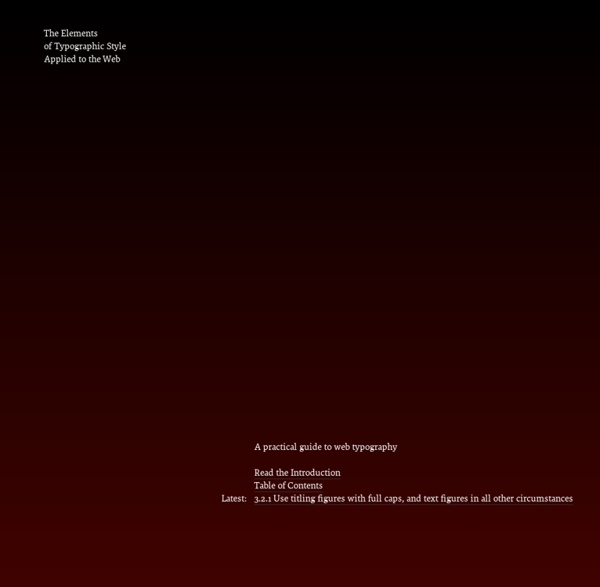



AJAX, DHTML and JavaScript Libraries Today JavaScript is widely used by web developers. There are a lot of libraries to add special effects, simple way to implement Ajax, complex components, forms, tabs or everything else. Here’s a collection of Ajax, Javascript and DHTML Libraries. The Elements of Typographic Style The Elements of Typographic Style is the authoritative book on typography and style by Canadian typographer, poet and translator Robert Bringhurst. Originally published in 1992 by Hartley & Marks Publishers, it was revised in 1996, 2001 (v2.4), 2002 (v2.5), 2004 (v3.0), 2005 (v3.1), 2008 (v3.2), and 2012 (v4.0). A history and guide to typography, it has been praised by Hermann Zapf, who said “I wish to see this book become the Typographers’ Bible.”[1] Jonathan Hoefler and Tobias Frere-Jones consider it "the finest book ever written about typography," according to the FAQ section of their type foundry's website.[2] Because of its status as a respected and frequently cited resource, typographers and designers often refer to it simply as Bringhurst.
CSS Sliding Door using only 1 image Before I know about this technique, I was using different images for each of the button I needed in a navigation bar. I found that it is not user friendly and also need more CSS coding. Besides, it is increasing the processing time and bandwidth in loading a site. In this tutorial, I will show you how to code the navigation bar using only 1 image. I will not cover the image creation part because I think you should know how to do that after follow few of my tutorials in the past. 50 Beautiful Flash Websites - Smashing Magazine Advertisement Flash enabled designers and developers to deliver rich content over the browsers, creating motion, interactivity and an impressive visual experience. Good Flash-sites do not require too much bandwidth, load fast and allow for a smooth interaction; besides, beautiful Flash-based sites are Photoshop masterpieces, transporting some kind of reality and fantasy to the Flash movie.
Typograph – Scale & Rhythm This page falls somewhere between a tool and an essay. It sets out to explore how the intertwined typographic concepts of scale and rhythm can be encouraged to shake a leg on web pages. Drag the colored boxes along the scale to throw these words anew. Top 10 Web Designer Job Skills - List of Web Designer Job Skills - Top Skills for a Web Designer or Developer Whether you are just starting out as a Web designer or Web developer or are looking to become one, there are skills you need to know to be successful. The following list of technical skills is a list of the skills you need to be a good Web designer. They are listed in importance to getting a job as a Web designer, although some may be in higher demand than others. The list includes information about the skill, where to learn more about it, training resources, and whether it's more useful to a Web designer or a Web developer. HTML is the most important thing a Web designer or Web developer can learn.
50 Essential Free Open Courseware Classes for Web Designers Web design is an increasingly important aspect of media and business. Because the Internet has become essential to the way we do business, find information and accomplish a number of other tasks, Web design truly is vital. And someone who understands Web design and can do a good job with it is valuable in a number of ways. If you are interested in improving your web design skills, here are 50 great open courseware classes for web designers: Computers and Computing Understanding computers and computing is your first order of business. CSS3 Patterns, Explained Many of you have probably seen my CSS3 patterns gallery. It became very popular throughout the year and it showed many web developers how powerful CSS3 gradients really are. But how many really understand how these patterns are created? The biggest benefit of CSS-generated backgrounds is that they can be modified directly within the style sheet. This benefit is void if we are just copying and pasting CSS code we don’t understand. We may as well use a data URI instead.